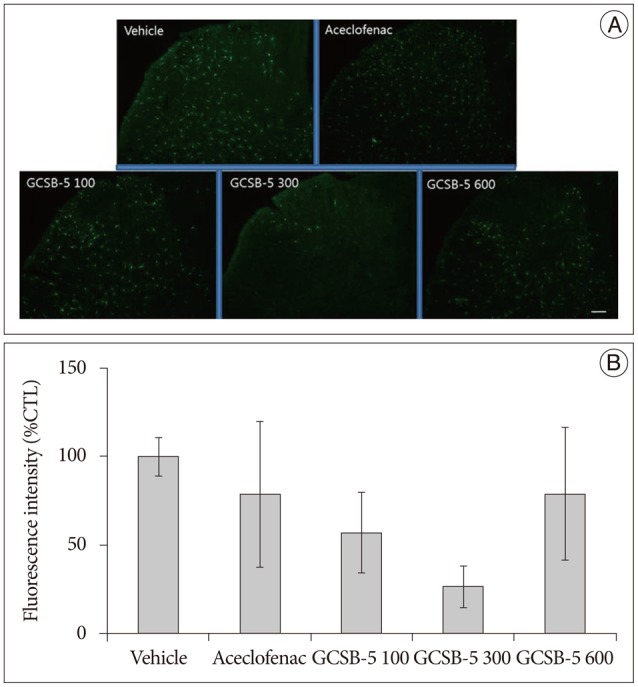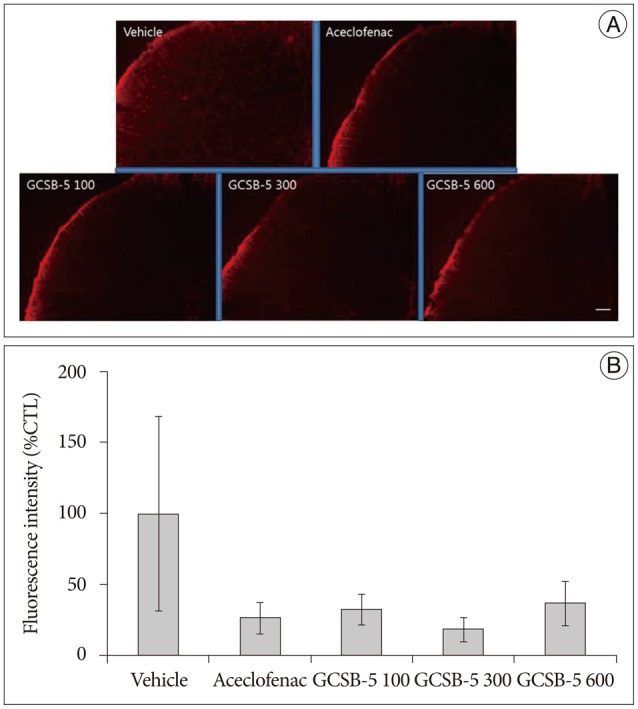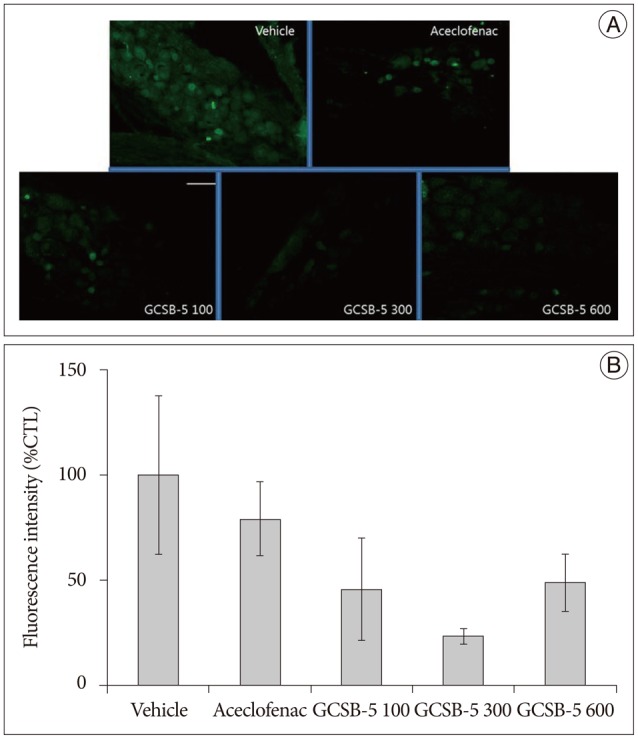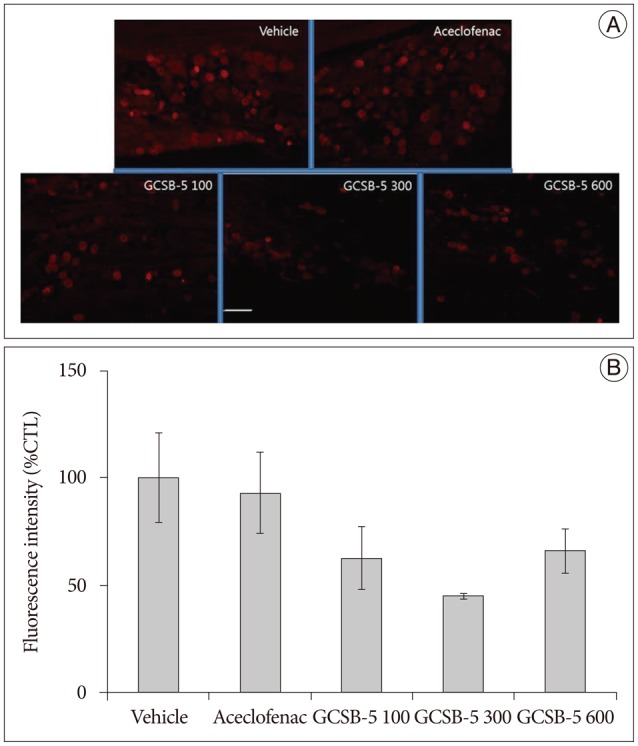J Korean Neurosurg Soc.
2016 Mar;59(2):98-105. 10.3340/jkns.2016.59.2.98.
The Effect of GCSB-5 a New Herbal Medicine on Changes in Pain Behavior and Neuroglial Activation in a Rat Model of Lumbar Disc Herniation
- Affiliations
-
- 1Department of Physical Medicine and Rehabilitation, College of Medicine, Catholic University of Daegu, Daegu, Korea.
- 2Medical Devices Clinical Trial Center, College of Medicine, Yeungnam University, Daegu, Korea. spineahn@ynu.ac.kr
- 3Department of Physical Medicine and Rehabilitation, College of Medicine, Yeungnam University, Daegu, Korea.
- 4Department of Medical Statistics, College of Medicine, Catholic University of Daegu, Daegu, Korea.
- KMID: 2192038
- DOI: http://doi.org/10.3340/jkns.2016.59.2.98
Abstract
OBJECTIVE
Lumbar disc herniation can induce sciatica by mechanical compression and/or chemical irritation. The aim of this study was to compare the effects of GCSB-5 (Shinbaro(R)) and NSAIDs on pain-related behavior and on the expressions of microglia, astrocytes, CGRP, TRPV1, IL-6, and CX3CL1 in a rat model of lumbar disc herniation.
METHODS
112 male Sprague-Dawley rats underwent implantation of nucleus pulposus to a dorsal root ganglion (DRG). Rats were divided into five groups as follows; a saline group (the vehicle control group) (n=27), a 10 mg/kg aceclofenac group (the aceclofenac group) (n=22), and 100, 300 or 600 mg/kg GCSB-5 groups (the GCSB-5 100, 300, or 600 groups) (n=21 for each group). Rats were tested for mechanical allodynia at 3 days after surgery and at 1 day, 3 days, 7 days, 14 days, 21 days, 28 days, 35 days, 42 days, 49 days, and 56 days after treatment commencement. Immunohistochemical staining of microglia (Iba1), astrocytes (GFAP), CGRP, and TRPV1, and PCR for IL-6 and CX3CL1 were performed on spinal dorsal horns and DRGs at 56 days after medication commencement.
RESULTS
After 56 days of GCSB-5 300 administration, mechanical withdrawal thresholds were significantly increased (p<0.05), and immunohisto-chemical expressions of Iba1, GFAP, CGRP, and TRPV1 were reduced than other groups, but this difference was not statistically significant.
CONCLUSION
These results indicate GCSB-5 reduces mechanical allodynia and downregulates neuroglial activity and the expressions of CGRP and TRPV1 in the spinal segments of a rat model of lumbar disc herniation.
Keyword
MeSH Terms
-
Animals
Anti-Inflammatory Agents, Non-Steroidal
Astrocytes
Calcitonin Gene-Related Peptide
Diagnosis-Related Groups
Ganglia, Spinal
Herbal Medicine*
Horns
Humans
Hyperalgesia
Interleukin-6
Male
Microglia
Models, Animal*
Neuralgia
Polymerase Chain Reaction
Rats*
Rats, Sprague-Dawley
Sciatica
Anti-Inflammatory Agents, Non-Steroidal
Calcitonin Gene-Related Peptide
Interleukin-6
Figure
Cited by 1 articles
-
Medical treatment of osteoarthritis: botanical pharmacologic aspect
Junyong Park, Sung Won Lee
J Rheum Dis. 2024;31(2):68-78. doi: 10.4078/jrd.2023.0084.
Reference
-
1. Ahn SH, Cho YW, Ahn MW, Jang SH, Sohn YK, Kim HS. mRNA expression of cytokines and chemokines in herniated lumbar intervertebral discs. Spine (Phila Pa 1976). 2002; 27:911–917. PMID: 11979160.
Article2. Anzai H, Hamba M, Onda A, Konno S, Kikuchi S. Epidural application of nucleus pulposus enhances nociresponses of rat dorsal horn neurons. Spine (Phila Pa 1976). 2002; 27:E50–E55. PMID: 11805708.
Article3. Aoki Y, Rydevik B, Kikuchi S, Olmarker K. Local application of disc-related cytokines on spinal nerve roots. Spine (Phila Pa 1976). 2002; 27:1614–1617. PMID: 12163720.
Article4. Brisby H, Byröd G, Olmarker K, Miller VM, Aoki Y, Rydevik B. Nitric oxide as a mediator of nucleus pulposus-induced effects on spinal nerve roots. J Orthop Res. 2000; 18:815–820. PMID: 11117305.
Article5. Burke JG, Watson RW, McCormack D, Dowling FE, Walsh MG, Fitzpatrick JM. Spontaneous production of monocyte chemoattractant protein-1 and interleukin-8 by the human lumbar intervertebral disc. Spine (Phila Pa 1976). 2002; 27:1402–1407. PMID: 12131736.
Article6. Chen Y, Willcockson HH, Valtschanoff JG. Influence of the vanilloid receptor TRPV1 on the activation of spinal cord glia in mouse models of pain. Exp Neurol. 2009; 220:383–390. PMID: 19815011.
Article7. Chung HJ, Lee HS, Shin JS, Lee SH, Park BM, Youn YS, et al. Modulation of acute and chronic inflammatory processes by a traditional medicine preparation GCSB-5 both in vitro and in vivo animal models. J Ethnopharmacol. 2010; 130:450–459. PMID: 20621661.
Article8. Cuellar JM, Montesano PX, Carstens E. Role of TNF-alpha in sensitization of nociceptive dorsal horn neurons induced by application of nucleus pulposus to L5 dorsal root ganglion in rats. Pain. 2004; 110:578–587. PMID: 15288398.
Article9. Ding M, Hart RP, Jonakait GM. Tumor necrosis factor-alpha induces substance P in sympathetic ganglia through sequential induction of interleukin-1 and leukemia inhibitory factor. J Neurobiol. 1995; 28:445–454. PMID: 8592105.
Article10. Ge WH, Guo JY, Shen YJ, Chen ML, Shi SL, Han YH, et al. [Effects of volatie oil of Schizonepeta tenuifolia Briq herb and Saposhnikovia divaricata Schischke root on proinflammatory cytokine expression and regulation]. Zhongguo Zhong Yao Za Zhi. 2007; 32:1777–1179. PMID: 17993000.11. Hatashita S, Sekiguchi M, Kobayashi H, Konno S, Kikuchi S. Contralateral neuropathic pain and neuropathology in dorsal root ganglion and spinal cord following hemilateral nerve injury in rats. Spine (Phila Pa 1976). 2008; 33:1344–1351. PMID: 18496347.
Article12. Hong ND, Rho YS, Kim JW, Won DH, Kim NJ, Cho BS. Studies on the general pharmacological activities of Eucommia ulmoides Oliver. Korean J Pharmacogn. 1988; 19:102–110.13. Hua XY, Chen P, Fox A, Myers RR. Involvement of cytokines in lipopolysaccharide-induced facilitation of CGRP release from capsaicin-sensitive nerves in the trachea : studies with interleukin-1beta and tumor necrosis factor-alpha. J Neurosci. 1996; 16:4742–4748. PMID: 8764661.
Article14. Ida Y, Satoh Y, Katsumata M, Nagasao M, Hirai Y, Kajimoto T, et al. Two novel oleanolic acid saponins having a sialyl Lewis X mimetic structure from Achyranthes fauriei root. Bioorg Med Chem Lett. 1998; 8:2555–2558. PMID: 9873579.
Article15. Igarashi T, Kikuchi S, Shubayev V, Myers RR. 2000 Volvo Award winner in basic science studies : exogenous tumor necrosis factor-alpha mimics nucleus pulposus-induced neuropathology. Molecular, histologic, and behavioral comparisons in rats. Spine (Phila Pa 1976). 2000; 25:2975–2980. PMID: 11145807.
Article16. Ito T, Ohtori S, Inoue G, Koshi T, Doya H, Ozawa T, et al. Glial phosphorylated p38 MAP kinase mediates pain in a rat model of lumbar disc herniation and induces motor dysfunction in a rat model of lumbar spinal canal stenosis. Spine (Phila Pa 1976). 2007; 32:159–167. PMID: 17224809.
Article17. Kallakuri S, Takebayashi T, Ozaktay AC, Chen C, Yang S, Wooley PH, et al. The effects of epidural application of allografted nucleus pulposus in rats on cytokine expression, limb withdrawal and nerve root discharge. Eur Spine J. 2005; 14:956–964. PMID: 15290408.
Article18. Kang JD, Georgescu HI, McIntyre-Larkin L, Stefanovic-Racic M, Donaldson WF 3rd, Evans CH. Herniated lumbar intervertebral discs spontaneously produce matrix metalloproteinases, nitric oxide, interleukin-6, and prostaglandin E2. Spine (Phila Pa 1976). 1996; 21:271–277. PMID: 8742201.
Article19. Kang JD, Stefanovic-Racic M, McIntyre LA, Georgescu HI, Evans CH. Toward a biochemical understanding of human intervertebral disc degeneration and herniation. Contributions of nitric oxide, interleukins, prostaglandin E2, and matrix metalloproteinases. Spine (Phila Pa 1976). 1997; 22:1065–1073. PMID: 9160463.
Article20. Kawakami M, Tamaki T, Hashizume H, Weinstein JN, Meller ST. The role of phospholipase A2 and nitric oxide in pain-related behavior produced by an allograft of intervertebral disc material to the sciatic nerve of the rat. Spine (Phila Pa 1976). 1997; 22:1074–1079. PMID: 9160464.
Article21. Kayama S, Konno S, Olmarker K, Yabuki S, Kikuchi S. Incision of the anulus fibrosus induces nerve root morphologic, vascular, and functional changes. An experimental study. Spine (Phila Pa 1976). 1996; 21:2539–2543. PMID: 8961440.
Article22. Kim BH, Park KS, Chang IM. Elucidation of anti-inflammatory potencies of Eucommia ulmoides bark and Plantago asiatica seeds. J Med Food. 2009; 12:764–769. PMID: 19735174.
Article23. Kim DS, Figueroa KW, Li KW, Boroujerdi A, Yolo T, Luo ZD. Profiling of dynamically changed gene expression in dorsal root ganglia post peripheral nerve injury and a critical role of injury-induced glial fibrillary acidic protein in maintenance of pain behaviors [corrected]. Pain. 2009; 143:114–122. PMID: 19307059.
Article24. Kim HW, Kwon YB, Ham TW, Roh DH, Yoon SY, Han HJ, et al. The antinociceptive and anti-inflammatory effect of ethylacetate extracts from Bang-Poong (Radix ledebouriellae) on the Freund's adjuvant-induced arthritis in rats. J Vet Sci. 2002; 3:343–349. PMID: 12819385.
Article25. Kim JK, Park SW, Kang JW, Kim YJ, Lee SY, Shin J, et al. Effect of GCSB-5, a herbal formulation, on monosodium iodoacetate-induced ssteoarthritis in rats. Evid Based Complement Alternat Med. 2012; 2012:730907. PMID: 22474519.26. Kim SJ, Kim WR, Kim HS, Park HW, Cho YW, Jang SH, et al. Abnormal spontaneous activities on needle electromyography and their relation with pain behavior and nerve fiber pathology in a rat model of lumbar disc herniation. Spine (Phila Pa 1976). 2011; 36:E1562–E1567. PMID: 21278630.
Article27. Lappin SC, Randall AD, Gunthorpe MJ, Morisset V. TRPV1 antagonist, SB-366791, inhibits glutamatergic synaptic transmission in rat spinal dorsal horn following peripheral inflammation. Eur J Pharmacol. 2006; 540:73–81. PMID: 16737693.
Article28. Marchand F, Perretti M, McMahon SB. Role of the immune system in chronic pain. Nat Rev Neurosci. 2005; 6:521–532. PMID: 15995723.
Article29. Norimoto M, Sakuma Y, Suzuki M, Orita S, Yamauchi K, Inoue G, et al. Up-regulation of pain behavior and glial activity in the spinal cord after compression and application of nucleus pulposus onto the sciatic nerve in rats. Asian Spine J. 2014; 8:549–556. PMID: 25346806.
Article30. Ohtori S, Takahashi K, Aoki Y, Doya H, Ozawa T, Saito T, et al. Spinal neural cyclooxygenase-2 mediates pain caused in a rat model of lumbar disk herniation. J Pain. 2004; 5:385–391. PMID: 15501196.
Article31. Ohtori S, Takahashi K, Moriya H, Myers RR. TNF-alpha and TNF-alpha receptor type 1 upregulation in glia and neurons after peripheral nerve injury : studies in murine DRG and spinal cord. Spine (Phila Pa 1976). 2004; 29:1082–1088. PMID: 15131433.
Article32. Olmarker K, Brisby H, Yabuki S, Nordborg C, Rydevik B. The effects of normal, frozen, and hyaluronidase-digested nucleus pulposus on nerve root structure and function. Spine (Phila Pa 1976). 1997; 22:471–475. discussion 476PMID: 9076877.
Article33. Olmarker K, Larsson K. Tumor necrosis factor alpha and nucleus-pulposus-induced nerve root injury. Spine (Phila Pa 1976). 1998; 23:2538–2544. PMID: 9854752.34. Olmarker K, Rydevik B, Nordborg C. Autologous nucleus pulposus induces neurophysiologic and histologic changes in porcine cauda equina nerve roots. Spine (Phila Pa 1976). 1993; 18:1425–1432. PMID: 8235812.
Article35. Park HW, Ahn SH, Kim SJ, Seo JM, Cho YW, Jang SH, et al. Changes in spinal cord expression of fractalkine and its receptor in a rat model of disc herniation by autologous nucleus pulposus. Spine (Phila Pa 1976). 2011; 36:E753–E760. PMID: 21224760.
Article36. Patwardhan AM, Scotland PE, Akopian AN, Hargreaves KM. Activation of TRPV1 in the spinal cord by oxidized linoleic acid metabolites contributes to inflammatory hyperalgesia. Proc Natl Acad Sci U S A. 2009; 106:18820–18824. PMID: 19843694.
Article37. Rand N, Reichert F, Floman Y, Rotshenker S. Murine nucleus pulposus-derived cells secrete interleukins-1-beta, -6, and -10 and granulocyte-macrophage colony-stimulating factor in cell culture. Spine (Phila Pa 1976). 1997; 22:2598–2601. discussion 2602PMID: 9399443.
Article38. Sekiguchi M, Otoshi K, Kikuchi S, Konno S. Analgesic effects of prostaglandin E2 receptor subtype EP1 receptor antagonist : experimental study of application of nucleus pulposus. Spine (Phila Pa 1976). 2011; 36:1829–1834. PMID: 21270690.
Article39. Spicarova D, Palecek J. The role of the TRPV1 endogenous agonist N-Oleoyldopamine in modulation of nociceptive signaling at the spinal cord level. J Neurophysiol. 2009; 102:234–243. PMID: 19369364.
Article40. Takahashi H, Suguro T, Okazima Y, Motegi M, Okada Y, Kakiuchi T. Inflammatory cytokines in the herniated disc of the lumbar spine. Spine (Phila Pa 1976). 1996; 21:218–224. PMID: 8720407.
Article41. Takeda M, Tanimoto T, Kadoi J, Nasu M, Takahashi M, Kitagawa J, et al. Enhanced excitability of nociceptive trigeminal ganglion neurons by satellite glial cytokine following peripheral inflammation. Pain. 2007; 129:155–166. PMID: 17127002.
Article42. Tsuda M, Inoue K, Salter MW. Neuropathic pain and spinal microglia : a big problem from molecules in "small" glia. Trends Neurosci. 2005; 28:101–107. PMID: 15667933.
Article43. Vane J, Botting R. Inflammation and the mechanism of action of anti-inflammatory drugs. FASEB J. 1987; 1:89–96. PMID: 3111928.
Article44. Wang CC, Chen LG, Yang LL. Inducible nitric oxide synthase inhibitor of the Chinese herb I. Saposhnikovia divaricata (Turcz.) Schischk. Cancer Lett. 1999; 145:151–157. PMID: 10530783.
Article45. Watkins LR, Maier SF. Beyond neurons : evidence that immune and glial cells contribute to pathological pain states. Physiol Rev. 2002; 82:981–1011. PMID: 12270950.
Article46. Watkins LR, Maier SF. Glia : a novel drug discovery target for clinical pain. Nat Rev Drug Discov. 2003; 2:973–985. PMID: 14654796.
Article47. Watkins LR, Martin D, Ulrich P, Tracey KJ, Maier SF. Evidence for the involvement of spinal cord glia in subcutaneous formalin induced hyperalgesia in the rat. Pain. 1997; 71:225–235. PMID: 9231865.
Article48. Yabuki S, Kikuchi S, Olmarker K, Myers RR. Acute effects of nucleus pulposus on blood flow and endoneurial fluid pressure in rat dorsal root ganglia. Spine (Phila Pa 1976). 1998; 23:2517–2523. PMID: 9854750.
Article49. Zhu J, Gao X, Xie WL, Jin YZ, Sun WJ. [Effect of geniposide on serum IL-1beta and TNF-alpha of rheumatoid arthritis rats]. Zhongguo Zhong Yao Za Zhi. 2005; 30:708–711. PMID: 16075741.
- Full Text Links
- Actions
-
Cited
- CITED
-
- Close
- Share
- Similar articles
-
- Rapid Repeated Recurrent Lumbar Disc Herniation after Microscopic Discectomies
- Lumbar Disc Screening Using Back Pain Questionnaires: Oswestry Low Back Pain Score, Aberdeen Low Back Pain Scale, and Acute Low Back Pain Screening Questionnaire
- Natural History and Clinical Manifestations of Lumbar Disc Herniation
- The Relationship between Lumbar Shape and Lumbar Disc Herniation
- Clinical Analysis of Recurrent Lumbar Disc Herniation








